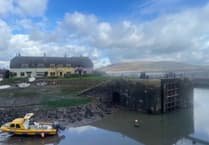TWO settlements in rural Somerset could end up being separated by only a couple of fields if current and planned housing growth continues. The town of Watchet and the village of Williton both lie in the heart of rural west Somerset with the former being a growing cultural pull for tourists and the latter a vital hub for services on the main road between Minehead and Taunton.
Both settlements are expected to deliver considerable amounts of new housing over the next two decades, with west Somerset being one of the few parts of the county not currently stymied by the Dutch N court ruling on phosphates.
With homes currently being built at Watchet’s southern edge and further homes planned for the northern tip of Williton, these two communities will end up even closer together (at least geographically speaking) than they currently are.
What is the phosphates problem?
The Dutch N court ruling, and the ensuring legal advice from Natural England, prohibits any net increase in phosphate levels within the catchment area of the Somerset Levels and Moors RAMSAR site, which is protected by international law.
Around 18,000 new homes across Somerset have been held up as councils and developers have worked to secure mitigation against any phosphate increases – whether through creating new wetlands, fallowing agricultural land, or purchasing ‘phosphate credits’ to offset the problem for a specific site.
The former West Somerset area – which is now part of the unitary Somerset Council – is largely not impacted by the ruling, since very few of its rivers flow onto the Levels and Moors.
Because less mitigation is needed, it is currently much easier for developers to construct homes in smaller rural settlements in West Somerset than it is for them to build in urban areas such as Taunton or Yeovil (though Bridgwater is downstream of the catchment area and therefore less adversely affected).
Councillor Loretta Whetlor, who represented Watchet and Williton on Somerset West and Taunton Council, stated in January: “Living in Watchet and the problems we’ve had [with developers] – I think we’ve had more windfall sites than anywhere.
“It seems as though where phosphates happen in one part of Somerset, we say: ‘let’s build them in Watchet, Williton and Minehead because they don’t have phosphate problems’.”
What about the Local Plan?
The phosphates issue is not the only planning conundrum facing this part of Somerset – there are also issue surrounding its Local Plan.
The West Somerset Local Plan, which runs until 2032, identified a number of sites in both Watchet and Williton where future housing growth would be expected to happen.
The plan was carried over into the new council, and is expected to be reviewed over the coming years as part of an effort to create a new Local Plan for the whole of Somerset.
An earlier review by Somerset West and Taunton Council identified a number of sites which could be delivered over the next two decades, which include the land to the west and north of Williton and the Liddymore Park site in Watchet, at the town’s southern edge.
With the housing crisis not going away any time soon, it is unlikely that any of these site will be removed from the new Local Plan when it is finalised.
How do things stand in Williton?
There are currently three major sites of interest regarding new housing in Wellington – the Orchard Brooks site, the west Williton allocation, and the north Williton allocation.
The Orchard Brooks site, which lies off Doniford Road at the north-eastern edge of the village, is currently in the later stages of being built out, with Linden Homes expected to finish the last of the 90 homes approved there by early-2024.
Both this and the west Williton site, which lies north of the A39 Priest Street, were originally owned by the Wyndham Estate before being brought forward for development.
The Wyndham Estate secured outline planning permission in November 2021 to build up to 350 new homes north of Priest Street, along with employment land, a new health centre and other leisure facilities for the village.
The plans (which critics said could turn Williton into “the Milton Keynes of the south west”) include retaining a large amount of green open space between the new homes and the existing edge of the village, as well as securing the public right of way which runs south of Williton Community Hospital on Shudgate Meadow.
The north Williton allocation lies to the north of Danesfield Church of England Middle School, and stretches from the B3191 North Road right across to Doniford Road.
The West Somerset Local Plan identifies that this site could accommodate up to 283 homes – and while no planning application has yet been submitted, it is predicted by officers that it could come forward within the next decade.
If approved, this latter development would push the built-up edge of Williton to the edge of the existing ridge near Grove Copse – just over a quarter of a mile from the edge of Watchet.
The Local Plan identifies a fourth site south of the A39 Long Street where up to 490 homes could be delivered by 2039.
However, this site requires significant mitigation to prevent localised flooding, and no planning application to develop it has yet been submitted.
Where do things stand in Watchet?
Five different large sites in Watchet were allocated within the Local Plan to deliver new homes, and each of them are at different stages of development.
These sites are:
- The Liddymore Park development on Liddymore Road
- The land either side of Normandy Avenue
- The former Wansborough Paper Mill on the B3191 Brendon Road
- The Parsonage Farm site on the B3191 Brendon Road
- The Cleeve Hill site on the B3191 Cleeve Hill
The closest of the sites to Williton is also the most advanced, with Summerfield Developments currently constructing the first phase of the Liddymore Park development off Liddymore Road.
The development will eventually deliver 250 homes near Knights Templar Church of England Primary School – which is also getting a larger car park as part of the legal agreement struck between the council and the developer.
When completed, this development will greatly extend Watchet’s southern edge further towards the existing ridge and the northern allocation in Williton.
Outline planning permission is also in place for 139 homes either side of Normandy Avenue – with Edenstone Homes putting forward revised proposals for the site in January.
Tameer Homes applied several years ago to redevelop the paper mill site, delivering 350 homes along with a hotel and leisure facilities – but Somerset Council is no closer to making a decision on the plans.
The paper mill site is also contentious because it could hypothetically be used to create a new road link to the B3191 west of Cleeve Hill, which has been closed indefinitely following concerns about coastal erosion.
The Parsonage Farm site, which hosts the annual Watchet LIVE Music Festival, is expected to deliver 440 new homes by 2032 – but no planning application has yet been submitted for the site.
Finally, the Cleeve Hill Development Group has made two attempts in the recent past to build 136 homes on the B3191 Cleeve Hill at the town’s western edge – offering to move the vulnerable coast road inland on both occasions.
Somerset West and Taunton Council refused the most recent plans in January – and it is not currently clear whether the developer will lodge an appeal to the Planning Inspectorate in a bid to get this overturned.
What is being done to improve connections between Williton and Watchet?
If Watchet and Williton are destined to move closer together, you’d like to think efforts were being made to make it easier to safely travel between the two.
The two settlements are currently served by two different road connections – the B3191 to the west, and Doniford Road from the east.
However, neither road is especially friendly for either pedestrians or cyclists, being steep, narrow in places and having limited pavements outside of the settlement boundaries.
Both settlements also lie on the West Somerset Railway – but this only operates heritage services, making it a less than viable option for commuting.
As part of the west Williton site’s outline approval, the Wyndham Estate promised to fund a new toucan crossing near Danesfield School (providing up to £200,000).
It also pledged to provide up to £500,000 to support two local bus services, allowing service 15 to operate on weekdays all year round (i.e. not just during term time) and allowing additional evening journeys on service 28 from Monday to Saturday.
Most relevantly for outward travel, the estate has promised £200,000 to help deliver 1,500 metres of new cycle paths on the Steam Coast Trail, which will eventually run uninterrupted between Williton and Minehead via Watchet, Blue Anchor and Dunster.
The existing Steam Coast Trail runs from North Road up Grove Copse, following the route of the West Somerset Coast Path; however, the short stretch between the copse and Woodland Road in Watchet is not especially accessible for cyclists, and may be high on the priority list to upgrade.
What happens next?
Any decisions on future major developments in either Watchet or Williton will be made in public by Somerset Council’s planning committee west, which meets once a month.
Any decisions on active travel spending may be taken either as part of decisions on individual applications – or individual schemes could be proposed to the council’s executive committee.
The council has received £1,583,322 of active travel funding in its most recent bid to the Department for Transport – but it has yet to disclose how and where in Somerset this money will be spent.
Councillor Mike Rigby, portfolio holder for transport and digital, has indicated his enthusiasm for active travel schemes, with the council recently funding a £50,000 study into new routes which could connect Taunton to the nearby villages of Bishop’s Lydeard and Cotford St. Luke.
Speaking in March, he said: “We are committed to growing our cycling and walking network – we need viable alternatives to car use for those travelling to work or school, both to protect the environment and to support people’s health and well-being.”




